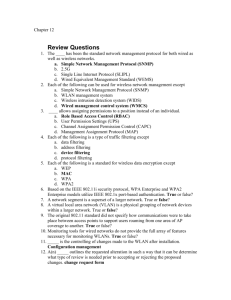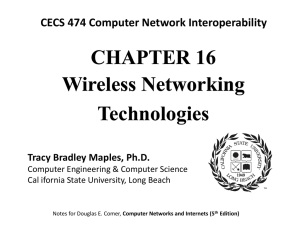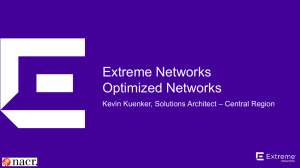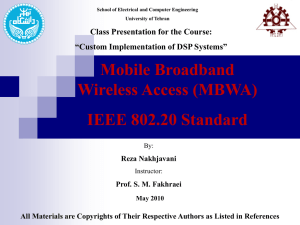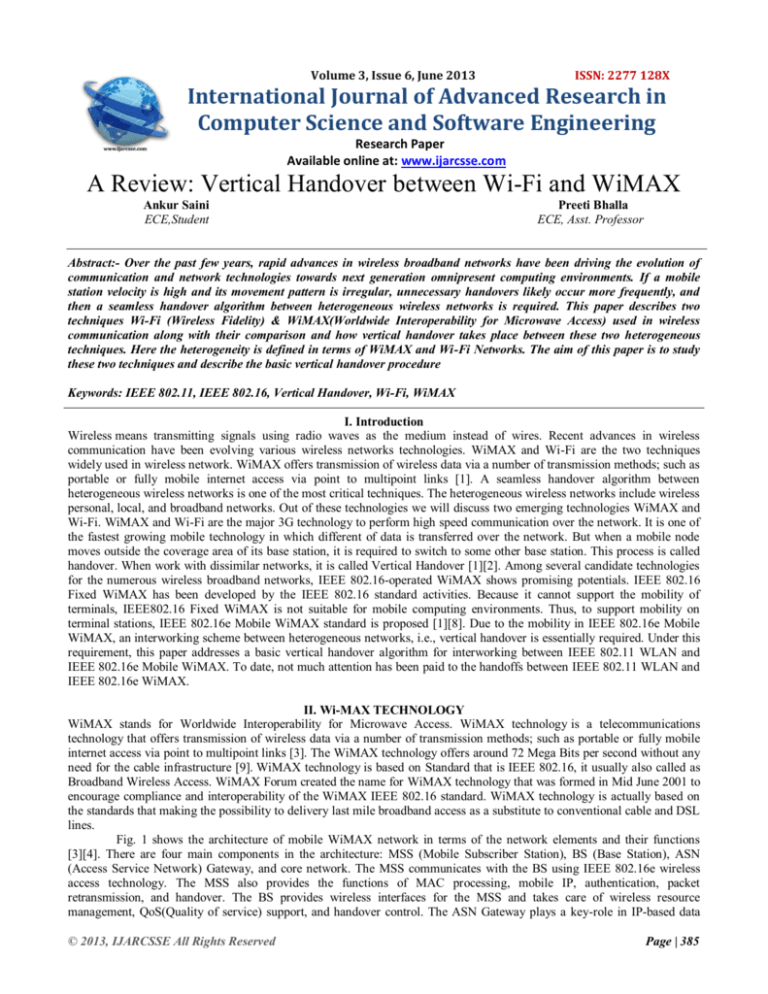
Volume 3, Issue 6, June 2013
ISSN: 2277 128X
International Journal of Advanced Research in
Computer Science and Software Engineering
Research Paper
Available online at: www.ijarcsse.com
A Review: Vertical Handover between Wi-Fi and WiMAX
Ankur Saini
ECE,Student
Preeti Bhalla
ECE, Asst. Professor
Abstract:- Over the past few years, rapid advances in wireless broadband networks have been driving the evolution of
communication and network technologies towards next generation omnipresent computing environments. If a mobile
station velocity is high and its movement pattern is irregular, unnecessary handovers likely occur more frequently, and
then a seamless handover algorithm between heterogeneous wireless networks is required. This paper describes two
techniques Wi-Fi (Wireless Fidelity) & WiMAX(Worldwide Interoperability for Microwave Access) used in wireless
communication along with their comparison and how vertical handover takes place between these two heterogeneous
techniques. Here the heterogeneity is defined in terms of WiMAX and Wi-Fi Networks. The aim of this paper is to study
these two techniques and describe the basic vertical handover procedure
Keywords: IEEE 802.11, IEEE 802.16, Vertical Handover, Wi-Fi, WiMAX
I. Introduction
Wireless means transmitting signals using radio waves as the medium instead of wires. Recent advances in wireless
communication have been evolving various wireless networks technologies. WiMAX and Wi-Fi are the two techniques
widely used in wireless network. WiMAX offers transmission of wireless data via a number of transmission methods; such as
portable or fully mobile internet access via point to multipoint links [1]. A seamless handover algorithm between
heterogeneous wireless networks is one of the most critical techniques. The heterogeneous wireless networks include wireless
personal, local, and broadband networks. Out of these technologies we will discuss two emerging technologies WiMAX and
Wi-Fi. WiMAX and Wi-Fi are the major 3G technology to perform high speed communication over the network. It is one of
the fastest growing mobile technology in which different of data is transferred over the network. But when a mobile node
moves outside the coverage area of its base station, it is required to switch to some other base station. This process is called
handover. When work with dissimilar networks, it is called Vertical Handover [1][2]. Among several candidate technologies
for the numerous wireless broadband networks, IEEE 802.16-operated WiMAX shows promising potentials. IEEE 802.16
Fixed WiMAX has been developed by the IEEE 802.16 standard activities. Because it cannot support the mobility of
terminals, IEEE802.16 Fixed WiMAX is not suitable for mobile computing environments. Thus, to support mobility on
terminal stations, IEEE 802.16e Mobile WiMAX standard is proposed [1][8]. Due to the mobility in IEEE 802.16e Mobile
WiMAX, an interworking scheme between heterogeneous networks, i.e., vertical handover is essentially required. Under this
requirement, this paper addresses a basic vertical handover algorithm for interworking between IEEE 802.11 WLAN and
IEEE 802.16e Mobile WiMAX. To date, not much attention has been paid to the handoffs between IEEE 802.11 WLAN and
IEEE 802.16e WiMAX.
II. Wi-MAX TECHNOLOGY
WiMAX stands for Worldwide Interoperability for Microwave Access. WiMAX technology is a telecommunications
technology that offers transmission of wireless data via a number of transmission methods; such as portable or fully mobile
internet access via point to multipoint links [3]. The WiMAX technology offers around 72 Mega Bits per second without any
need for the cable infrastructure [9]. WiMAX technology is based on Standard that is IEEE 802.16, it usually also called as
Broadband Wireless Access. WiMAX Forum created the name for WiMAX technology that was formed in Mid June 2001 to
encourage compliance and interoperability of the WiMAX IEEE 802.16 standard. WiMAX technology is actually based on
the standards that making the possibility to delivery last mile broadband access as a substitute to conventional cable and DSL
lines.
Fig. 1 shows the architecture of mobile WiMAX network in terms of the network elements and their functions
[3][4]. There are four main components in the architecture: MSS (Mobile Subscriber Station), BS (Base Station), ASN
(Access Service Network) Gateway, and core network. The MSS communicates with the BS using IEEE 802.16e wireless
access technology. The MSS also provides the functions of MAC processing, mobile IP, authentication, packet
retransmission, and handover. The BS provides wireless interfaces for the MSS and takes care of wireless resource
management, QoS(Quality of service) support, and handover control. The ASN Gateway plays a key-role in IP-based data
© 2013, IJARCSSE All Rights Reserved
Page | 385
Saini et al., International Journal of Advanced Research in Computer Science and Software Engineering 3(6),
June - 2013, pp. 385-389
services including IP packet routing, security, QoS and handover control. The ASN Gateway also interacts with the AAA
(Authentication, Authorization, and Accounting) server for user authentication and billing. To provide mobility for the MSS,
a ASN Gateway supports handover among the BSs while the mobile IP provides handover among ASN Gateways as shown
in Fig. 1.
Fig 1. Network Architecture of Mobile WiMAX [3][4]
III. Wi-Fi Technology
Wireless Fidelity (Wi-Fi) is a wireless technology which provides internet connectivity or connectivity among the users. In
1997 IEEE provide a set of specification and standards for Wi-Fi which is under the title 802.11 that explains the structure of
the comparatively short range radio signal for Wi-Fi service. After that several specifications came and most commonly used
specifications today are 802.11b, 802.11g and 802.11a [9]. Out of these three, 802.11a can provide higher speeds within the
various radio frequencies. IEEE is now working for a new standard 802.11n which is more reliable, secure and faster than the
other standard .Originally Wi-Fi was created for wireless extension for the wired LAN. That‟s why the distance between the
Wi-Fi access point and user equipment is limited to around 100 feet indoor and up to 300 feet outdoors [3]. So if a user
moves its computer to a new location, he/she should find a new access point for continuing the communication. Due to the
cheap availability of the equipment and its maintenance and servicing cost, Wi-Fi is widely accepted throughout the world
and it is widely used in a restaurants, hotels, airports and school campuses. It is also work well in the auditoriums, meeting
rooms and small businesses. Internet service providers also use it for individual home connectivity and connectivity to the
commercial complexes. All wireless devices that join a Wi-Fi network, whether mobile, portable or fixed, are called wireless
stations (STAs). A wireless station might be a PC, a laptop, a PDA or a phone. When two or more STAs are wirelessly
connected, they form a basic service set (BSS). This is the basic building block of a Wi-Fi network. The BSS is an example
of the simplest Wi-Fi network possible: two wireless stations. A common distribution system (DS) and two or more BSSs
create what is called an extended service set (ESS). An ESS is a Wi-Fi network of arbitrary size and complexity. Fig 2 is a
representation of an ESS comprised of BSS 1, 2 and 3. The distribution system is not part of the ESS. The distribution system
enables mobility in a Wi-Fi network by a method of tracking the physical location of STAs, thus ensuring that frames are
delivered to the AP associated with the destination STA. Mobility means a wireless client can move anywhere within the
coverage area of the ESS and keep an uninterrupted connection.
Fig 2. ESS (Extended Service Set)
These two wireless technologies have common components in their operations with a major difference in the communication
range. The following table below gives the detailed comparative analysis of the two broadband wireless access networks (WiFi and WiMAX):
© 2013, IJARCSSE All Rights Reserved
Page | 386
Saini et al., International Journal of Advanced Research in Computer Science and Software Engineering 3(6),
June - 2013, pp. 385-389
Table I. Comparison between WiMAX and Wi-Fi [7]
Feature
WiMAX(IEEE
802.16a)
Primary
Application
Broadband
Wireless Access
Frequency Band
Licensed/Unlicen
sed 2GHZ to
11GHz
<=5 bps/Hz
Bandwidth
Efficiency
Modulation
WiFi(IEEE
802.11b)
Wireless
LAN
2.4 GHz
ISM
<=0.44
bps/Hz
QPSK
Wi-Fi(IEEE
802.11a/g)
Wireless LAN
2.4 GHz ISM(g)
5 GHz U-NII(a)
<=2.7 bps/Hz
FEC
BPSK,QPSK,16,
64,256-QAM
Convolution
Code ReedSolomon
BPSK,QPSK
Convolution Code
Encryption
Mandatory-3DES
OptionalRC4
Optional- RC4
Mobility
Access Protocol
Request Grant
in
developme
nt
Vendor
Proprietary
CSMA/CA
In development
Mesh
Mobile
WiMAX(802.16e
)
Yes
None
Vendor Proprietary
CSMA/CA
IV. Comparison Between Wimax And Wi-Fi
WiMAX is different from Wi-Fi in many respects. In fact, Wi-Fi can operate at distances as great as WiMAX but there are
two reasons why it doesn't. One of the reasons is that radios operating in the unlicensed frequencies are not allowed to be as
powerful as those operated with licenses; and from convention, less power means less distance [7].The second reason as to
why Wi-Fi access points don't serve as wide an area as WiMAX is that the Wi-Fi MAC layer uses contention access. This
causes users to compete for data throughput to the access point. Wi-Fi even has problems with interference, and throughput
and that is why triple play (voice, data, and video) [7] technologies cannot be hosted on traditional Wi-Fi. In contrast, 802.16
use a scheduling algorithm (Xu, et al., 2006). This algorithm allows the user to only compete once for the access point. This
gives WiMAX inherent advantages in throughput, latency, spectral efficiency, and advanced antenna support. From the
technical point of view, it can be seen that both of these two wireless technologies are not basically addressed at the same
market but are very complementary. Wi-Fi is basically an implementation of wireless local area network within a short range
like a small building, a college or an institutional campus. WiMAX on the other hand is a metropolitan technology whose
objective is to interconnect houses, buildings or even hot spots to allow communication between them and with other
networks.
A. Advantages and Disadvantages of WiMAX and Wi-Fi
The WiMAX specification provides symmetrical bandwidth over many kilometers and range with stronger encryption
(TDES or AES) and typically less interference. Wi-Fi is short range (approximately 10's of meters) has WEP or WPA
encryption and suffers from interference as in metropolitan areas where there are many users [7].
It provides connectivity between network endpoints without the need for direct line of sight in favorable circumstances.
The non-line-of-sight propagation (NLOS) performance requires the .16d or .16e revisions, since the lower frequencies
are needed. It relies upon multi-path signals, somewhat in the manner of 802.11n.
One disadvantage of WiMAX is the spectral limitation, in other words limitation of wireless bandwidth. For use in high
density areas, it is possible that the bandwidth may not be sufficient to cater to the needs of a large clientele, driving the
costs high [9].
A disadvantage of WiMAX over Wi-Fi is that, where with Wi-Fi anyone can set up a wireless network for free, not
everyone can set up a WiMAX wireless network; and one must pay incredibly huge amounts of money to be given the
© 2013, IJARCSSE All Rights Reserved
Page | 387
Saini et al., International Journal of Advanced Research in Computer Science and Software Engineering 3(6),
June - 2013, pp. 385-389
right to set up a WiMAX wireless network in a region. This is because the frequency used by the WiMAX standard is
licensed by the government.
B. Which one is better WiMAX or Wi-Fi?
Although not being targeted on the same use, more recently WiMAX technology has several advantages compared to Wi-Fi.
Such as: a better reflection tolerance; a better penetration of obstacles; and an increased in the number of interconnections (a
few hundreds of equipment rather than some tens of equipment for Wi-Fi). It„s obvious that the WiMAX standard goal is not
to replace Wi-Fi in its applications but rather to supplement it in order to form a wireless network web. Despite the similarity
in equipment cost, WiMAX technology requires a costly infrastructure in contrast to Wi-Fi which can easily be installed
using low cost access points [7].
V. Vertical Handover
Diverse processes are required in order to perform a Vertical Handover (VHO).VHO process into three phases: i) Handover
information gathering, ii) Handover decision, and iii) Handover execution [2][3]. The information gathering phase is in
charge of collecting relevant information from diverse context sources such as network capabilities, access points, user
equipments, and user preferences. The most critical process in a VHO process is the decision phase since, depending on the
network candidate chosen, the performance of the system could improve or decrease. This decision should consider several
parameters in order to choose the best candidate network to hand over to [6]. The execution phase is in charge of committing
the VHO itself. In this process the UE (User Equipment) leaves the current network and gets attached to a new network in a
seamless manner, experiencing low latencies and minimal packet loss. This flow chart [Fig. 3] is about the selection of the
next target cell as a node move outside its coverage area. As it moves outside, number of possible base stations that are
having the coverage to that node will poll to get the access. The coverage will be decided under the distance coverage. The
presented flow chart is about to select this target base station. In flow chart we have defined multiple parameters. In this flow
chart to compare the Wi-Fi and WI-Max network and first of all define the network parameters such as capacity, distance,
bandwidth and diameters of the network after that to check the movement of the nodes i.e. either randomly or behalf of the
cluster head. Cluster head define the speeds and the direction of movement in the network area and cluster head also
identifying all the base station that are lies in these network area or to the target of particular node. Base station perform the
analysis of the nodes or the cluster head and to find the throughput of the nodes i.e. the number of the cycle to complete the
execution. Identify the error rate according to time frame schedule these are depends on time division multiplexing. Elect the
base station with accurate data to increasing throughput and calculate the speeds, diameters and to the target of the node.
Define the Wi-Fi Networks
Define the WiMAX Networks
Define network parameters like
capacity, distance etc
Define network parameters like
capacity, distance etc
Perform the Movement of random node outside the cluster head
Define the Speed and the Direction of the node
Identify all the base stations that are eligible to set as the target base
station for that node
Perform the analysis under speed, direction and fading throughput
Identify the Error Rate and Throughput Analysis under 2 time frames
Elect the base station with more accurate Increasing Throughput
Fig 3. Flow Chart of Vertical Handover
© 2013, IJARCSSE All Rights Reserved
Page | 388
Saini et al., International Journal of Advanced Research in Computer Science and Software Engineering 3(6),
June - 2013, pp. 385-389
VI. Conclusion
This paper has presented a precise description of two of the most prominent developing wireless access networks and even
discussed the method by which these technologies may collaborate together to form an alternatives for implementing lastmile wireless broadband services. Detailed technical comparative analysis between the 802.11 (Wi-Fi) and 802.16 (WiMAX)
wireless networks that provide alternative solution to the problem of information access in remote inaccessible areas where
wired networks are not cost effective has been looked into. As we have studied above one of the major problems of the
mobile networks is the degradation of the throughput during the handover mechanism. The presented work provides the
basic operation of a seamless vertical handover process that can takes place under hybrid networks in order to reduce the
error rate and improve throughput over the wireless communication.
References
Journals
[1]
Wonjun Lee,” Movement-Aware Vertical Handoff of WLAN and Mobile WiMAX for Seamless Ubiquitous Access”,
IEEE Transactions on Consumer Electronics 0098 3063/07 © 2007 IEEE
[2]
Bushra Naeem,” Seamless Vertical Handover in Wi-Fi and WiMAX Networks using RSS and Motion Detection: An
Investigation” The Pacific Journal of Science and Technology Volume 12. Number 1. May 2011 (spring)
[3]
Deep Kaur, Vishal Arora,” Research Agenda for Vertical Handover between WiMAX and Wi-Fi Networks”
International Journal of Emerging Research in Management &Technology ISSN: 2278-9359 January 2013
[4]
Jaeho Jo,” A Cross-layer Vertical Handover between Mobile WiMAX and 3G Networks”, 978-1-4244-2202-9/08©
2008 IEEE
[5]
Yu-Chang Chen,” Advanced seamless vertical handoff architecture for WiMAX and Wi-Fi heterogeneous networks
with QoS guarantees” Y.-C. Chen et al. / Computer Communications 32 (2009) 281–293
[6]
Deep Kaur, Vishal Arora, “Performance Analysis of Vertical Handover between WiMAX and Wi-Fi Network”
International Journal of Advanced Research in Computer Science and Software Engineering ISSN: 2277 128X
Volume 3, Issue 1, January 2013
[7]
Sourangsu Banerji,” Wi-Fi & WiMAX: A Comparative Study”
[8]
IEEE LAN/MAN Standards Committee, “IEEE Standard for Local and metropolitan area networks, Part 16: Air
Interface for Fixed Broadband wireless Access Systems,” IEEE Std 802.16-2001, 2001.
Books
[9]
Theodore S.Reppeport, Wireless Communications Principles and Practice, IEEE Press,Prentice Hall.
© 2013, IJARCSSE All Rights Reserved
Page | 389

